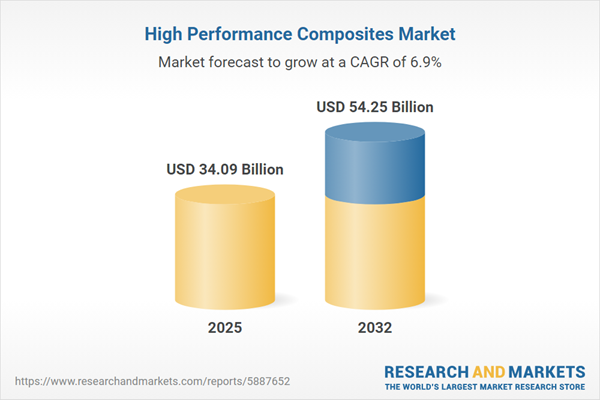Speak directly to the analyst to clarify any post sales queries you may have.
High performance composites are redefining product design for critical industries by enabling lighter, stronger, and more sustainable solutions. Their advanced material properties and evolving manufacturing technologies are helping organizations unlock new efficiencies and address demanding market conditions.
Market Snapshot: High Performance Composites Market Growth and Trends
The High Performance Composites Market grew from USD 31.88 billion in 2024 to USD 34.09 billion in 2025. With a projected CAGR of 6.87%, the market is expected to reach USD 54.25 billion by 2032.
This growth reflects surging demand for advanced composites across aerospace, automotive, energy, and other sectors seeking solutions for material strength, weight reduction, and efficiency.Scope & Segmentation of the High Performance Composites Market
This report delivers an in-depth analysis of high performance composites, covering comprehensive market segmentation by application, product type, region, and key industry verticals.
- Application Areas: Aerospace and defense (including commercial aircraft, military aviation, and spacecraft), automotive (commercial vehicles, motorsports, passenger vehicles), energy (oil and gas, wind, solar), industrial (construction, electronics, marine), and sporting goods (golf, tennis).
- Fiber Types: Aramid fiber (Kevlar 29, Kevlar 49, Twaron), basalt fiber (chopped, roving, woven forms), carbon fiber (high, intermediate, standard, ultra-high modulus), glass fiber (C-glass, E-glass, S-glass).
- Resin Types: Epoxy (standard, high temperature, and toughened grades), PEEK (reinforced, unreinforced), polyester (DCPD, isophthalic, orthophthalic), vinyl ester (standard, brominated).
- Manufacturing Processes: Compression molding (bulk and sheet molding compound), filament winding (dry, wet), hand layup (open, closed mold), prepreg (autoclave cure, out-of-autoclave), pultrusion (multi axis, standard), resin transfer molding (light and vacuum-assisted RTM).
- Forms: Filament, paste, pellet, powder, prepreg.
- End Users: Aerospace and defense, automotive, energy equipment manufacturers, industrial equipment manufacturers, sports equipment manufacturers.
- Regional Analysis: Americas (North, Central, and South America), Europe, Middle East & Africa, Asia-Pacific—with specific coverage for major sub-regions and countries.
- Key Companies Profiled: Toray Industries, Hexcel Corporation, SGL Carbon SE, Solvay SA, Owens Corning, Teijin Limited, Gurit Holding AG, Mitsubishi Chemical Holdings Corporation, Victrex plc, Huntsman International LLC.
Key Takeaways for Senior Decision-Makers
- Adoption of high modulus fibers and sustainable resins is accelerating the evolution of performance-driven applications in aerospace, automotive, and beyond.
- Advanced manufacturing technologies, such as automated fiber placement and digital twins, are streamlining production and design validation, contributing to improved reliability and shorter certification cycles.
- Regional supply chain recalibration is ongoing, especially in response to evolving tariff regulations, with greater emphasis on nearshoring and local sourcing strategies.
- Material recyclability and closed-loop processes are gaining strategic focus, driving collaborative innovation for greener composite solutions.
- Collaboration among OEMs, materials innovators, and research institutions is expediting the commercialization of next-generation composites tailored for sector-specific needs.
Impact of Tariff Revisions on High Performance Composites
Recent United States tariff updates have prompted organizations to diversify sourcing and enhance domestic supplier partnerships, aiming to offset increased input costs associated with imported fibers and resins. Companies are adopting dual-sourcing frameworks, digital supplier tracking, and regional production investments to maintain resilience and safeguard innovation pipelines.
Methodology & Data Sources
Insights are grounded in primary engagements with industry experts and secondary research from peer-reviewed publications and market databases. Data triangulation ensures accuracy, while qualitative and quantitative findings undergo rigorous internal validation and scenario testing.
Why This Report Matters for Your Business
- Enables strategic planning by providing clear intelligence on technological trends, regulatory pressures, and market segmentation across regions and applications.
- Guides resource allocation as organizations adapt to dynamic supply chain realities, sustainability mandates, and cross-sector competition.
Conclusion
The high performance composites market is defined by fast-paced innovation and evolving end-user demands. Informed decisions on sourcing, technology, and sustainability are key to achieving operational advantage and market growth.
Additional Product Information:
- Purchase of this report includes 1 year online access with quarterly updates.
- This report can be updated on request. Please contact our Customer Experience team using the Ask a Question widget on our website.
Table of Contents
3. Executive Summary
4. Market Overview
7. Cumulative Impact of Artificial Intelligence 2025
Companies Mentioned
The companies profiled in this High Performance Composites market report include:- Toray Industries, Inc.
- Hexcel Corporation
- SGL Carbon SE
- Solvay SA
- Owens Corning
- Teijin Limited
- Gurit Holding AG
- Mitsubishi Chemical Holdings Corporation
- Victrex plc
- Huntsman International LLC
Table Information
| Report Attribute | Details |
|---|---|
| No. of Pages | 187 |
| Published | October 2025 |
| Forecast Period | 2025 - 2032 |
| Estimated Market Value ( USD | $ 34.09 Billion |
| Forecasted Market Value ( USD | $ 54.25 Billion |
| Compound Annual Growth Rate | 6.8% |
| Regions Covered | Global |
| No. of Companies Mentioned | 11 |









